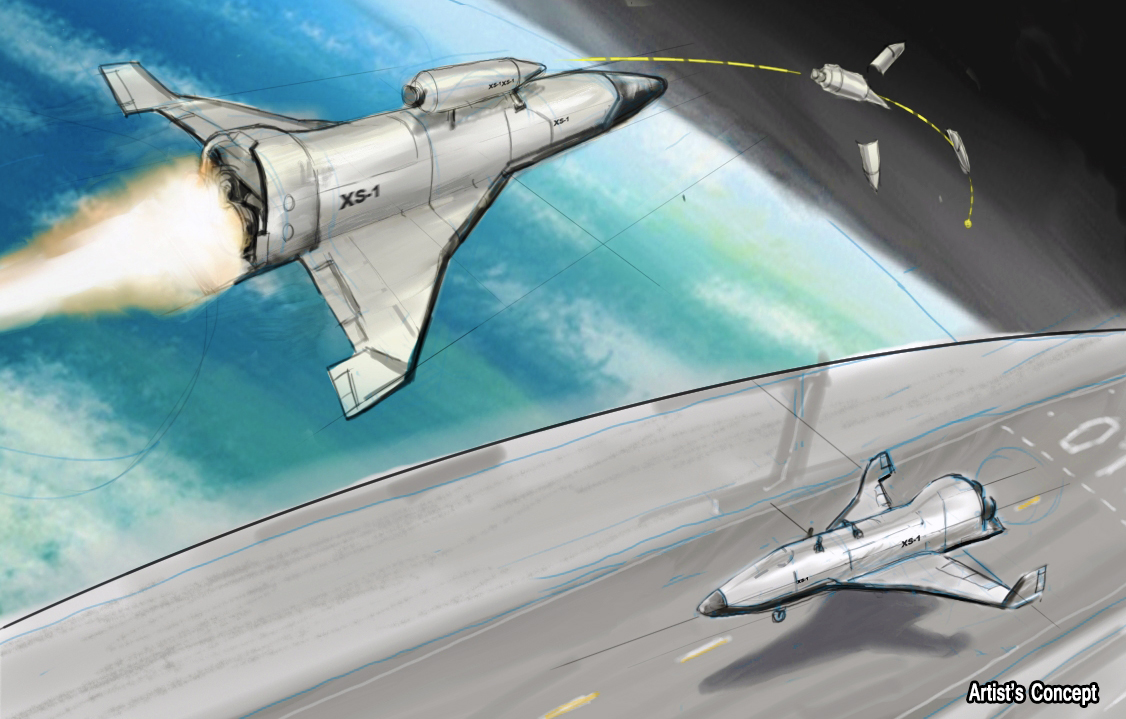US Military's XS-1 Space Plane Project Seeks $27 Million in 2015 Funding

WASHINGTON — The U.S. Defense Advanced Research Projects Agency expects to spend some $800 million on space programs from 2015 through 2018, an increase of $130 million over what was projected at this time last year, Defense Department budget documents show.
Nearly all of the targeted increase for DARPA's Space Programs and Technology Office is backloaded into the outyears, the documents show. For 2015, the office is seeking nearly $180 million, only $7.5 million more than this year’s funding level.
DARPA's budget books break out funding on a program-by-program basis for the upcoming fiscal year only; outyear projections are provided only at the department level. [NASA Space Tech, Science & Exploration Goals in 2015 (Gallery)]

DARPA's mission, generally speaking, is to pursue high-risk, high-payoff technology development projects that could someday benefit the military. These projects are taken on with the understanding that many, if not most, will fail. Defense Department officials often talk about "DARPA-hard" programs to describe their degree of difficulty.
For example, the 2015 request includes $27 million for XS-1, a concept for a reusable space plane that could ultimately fly 10 times in 10 days and boost payloads into low-Earth orbit for less than $5 million per launch. The program received $10 million in 2014.
"Technologies derived from the XS-1 program will enable routine space launch capabilities with aircraft-like cost, operability and reliability," a DARPA announcement from November 2013 reads. "The long-term intent is for XS-1 technologies to be transitioned to support not only next-generation launch for Government and commercial customers, but also global reach hypersonic and space access aircraft."
The agency hopes to select a single vendor next year for the final design and development of the vehicle, which could make its initial test flight in 2018.
Get the Space.com Newsletter
Breaking space news, the latest updates on rocket launches, skywatching events and more!
DARPA sees the program potentially transitioning to the Air Force, the Navy or a commercial operator, the budget documents said.
The budget request also includes $55 million for the Airborne Launch Assist Space Access (ALASA) program, which is intended to field a system to launch satellites weighing up to 100 lbs (45 kilograms) for $1 million each. The agency requested $42 million for the program in fiscal year 2014.
DARPA awarded ALASA system concept studies contracts last year to Boeing, Lockheed Martin and Virgin Galactic, and technology-development contracts to three other companies.
The program is aiming for a demonstration launch in fiscal year 2015.
DARPA is requesting $65 million for the Phoenix program next year, compared with $60 million this year, according to the agency budget documents. Phoenix is an on-orbit robotics technologies program originally intended, in part, to salvage components from aging satellites.
DARPA plans to test a core element of the program known as satlets — small modules that perform critical satellite functions including power, pointing and communications — by launching them into a low-inclination orbit as soon as 2015.
The budget request also includes $5 million for what appears to be a new program dubbed the Optical Aperture Self-Assembly in Space, which is intended to demonstrate the "feasibility of constructing large optical apertures in orbit from a number of smaller modular components that self-organize in space."
The request discontinues funding for two programs: an experimental solar electric propulsion vehicle and system F6, a planned formation-flying satellite demonstration that was canceled last year.
This story was provided by Space News, dedicated to covering all aspects of the space industry. Follow Mike Gruss on Twitter: @Gruss_SN.
Join our Space Forums to keep talking space on the latest missions, night sky and more! And if you have a news tip, correction or comment, let us know at: community@space.com.
Mike Gruss is a veteran defense reporter and Editor-in-Chief of Sightline Media Group, which includes Army Times, Air Force Times, Dense News, Military Times and Navy Times. From 2013 to 2016, Mike served as a Senior Staff Writer for SpaceNews covering national security space programs and military space policy in the U.S. Congress. Mike earned a bachelor's degree in English and American Studies from Miami University and has previously wrote for the Journal Gazette in Fort Wayne, Indiana and the Virginian-Pilot in Virginia before joining SpaceNews. Prior to joining Sightline in 2017, he was a senior editor of FedTech magazine covering technology in federal government. You can see Mike's latest project on Twitter.









